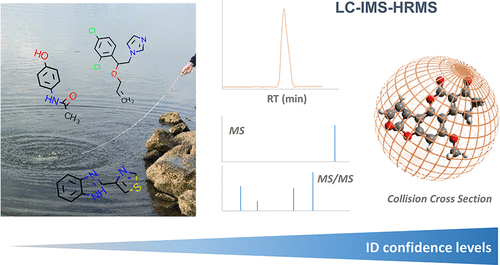当前位置:
X-MOL 学术
›
Environ. Sci. Technol.
›
论文详情
Our official English website, www.x-mol.net, welcomes your
feedback! (Note: you will need to create a separate account there.)
Improving Target and Suspect Screening High-Resolution Mass Spectrometry Workflows in Environmental Analysis by Ion Mobility Separation
Environmental Science & Technology ( IF 10.8 ) Pub Date : 2020-11-19 , DOI: 10.1021/acs.est.0c05713 Alberto Celma 1 , Juan V. Sancho 1 , Emma L. Schymanski 2 , David Fabregat-Safont 1 , María Ibáñez 1 , Jeff Goshawk 3 , Gitte Barknowitz 3 , Félix Hernández 1 , Lubertus Bijlsma 1
Environmental Science & Technology ( IF 10.8 ) Pub Date : 2020-11-19 , DOI: 10.1021/acs.est.0c05713 Alberto Celma 1 , Juan V. Sancho 1 , Emma L. Schymanski 2 , David Fabregat-Safont 1 , María Ibáñez 1 , Jeff Goshawk 3 , Gitte Barknowitz 3 , Félix Hernández 1 , Lubertus Bijlsma 1
Affiliation

|
Currently, the most powerful approach to monitor organic micropollutants (OMPs) in environmental samples is the combination of target, suspect, and nontarget screening strategies using high-resolution mass spectrometry (HRMS). However, the high complexity of sample matrices and the huge number of OMPs potentially present in samples at low concentrations pose an analytical challenge. Ion mobility separation (IMS) combined with HRMS instruments (IMS–HRMS) introduces an additional analytical dimension, providing extra information, which facilitates the identification of OMPs. The collision cross-section (CCS) value provided by IMS is unaffected by the matrix or chromatographic separation. Consequently, the creation of CCS databases and the inclusion of ion mobility within identification criteria are of high interest for an enhanced and robust screening strategy. In this work, a CCS library for IMS–HRMS, which is online and freely available, was developed for 556 OMPs in both positive and negative ionization modes using electrospray ionization. The inclusion of ion mobility data in widely adopted confidence levels for identification in environmental reporting is discussed. Illustrative examples of OMPs found in environmental samples are presented to highlight the potential of IMS–HRMS and to demonstrate the additional value of CCS data in various screening strategies.
中文翻译:

通过离子迁移分离改善环境分析中目标和可疑物筛选的高分辨率质谱工作流程
当前,监视环境样品中有机微量污染物(OMP)的最有效方法是使用高分辨率质谱(HRMS)进行目标,可疑和非目标筛选策略的组合。但是,样品基质的高度复杂性和低浓度样品中潜在存在的大量OMP构成了分析难题。离子淌度分离(IMS)与HRMS仪器(IMS–HRMS)相结合,引入了额外的分析范围,可提供额外的信息,从而有助于OMP的鉴定。IMS提供的碰撞截面(CCS)值不受基质或色谱分离的影响。所以,建立CCS数据库以及将离子迁移率纳入识别标准对增强和强大的筛选策略非常感兴趣。在这项工作中,使用电喷雾电离为正和负电离模式下的556个OMP开发了在线和免费提供的IMS-HRMS CCS库。讨论了将离子迁移率数据包括在广泛采用的置信度中,以便在环境报告中进行识别。介绍了在环境样品中发现的OMP的说明性例子,以突出IMS-HRMS的潜力并证明CCS数据在各种筛选策略中的附加价值。使用电喷雾电离技术为556种OMP分别开发了正离子和负离子两种模式。讨论了将离子迁移率数据包括在广泛采用的置信度中,以便在环境报告中进行识别。介绍了在环境样品中发现的OMP的说明性例子,以突出IMS-HRMS的潜力并证明CCS数据在各种筛选策略中的附加价值。使用电喷雾电离技术为556种OMP分别开发了正离子和负离子两种模式。讨论了将离子迁移率数据包括在广泛采用的置信度中,以便在环境报告中进行识别。介绍了在环境样品中发现的OMP的说明性例子,以突出IMS-HRMS的潜力并证明CCS数据在各种筛选策略中的附加价值。
更新日期:2020-12-01
中文翻译:

通过离子迁移分离改善环境分析中目标和可疑物筛选的高分辨率质谱工作流程
当前,监视环境样品中有机微量污染物(OMP)的最有效方法是使用高分辨率质谱(HRMS)进行目标,可疑和非目标筛选策略的组合。但是,样品基质的高度复杂性和低浓度样品中潜在存在的大量OMP构成了分析难题。离子淌度分离(IMS)与HRMS仪器(IMS–HRMS)相结合,引入了额外的分析范围,可提供额外的信息,从而有助于OMP的鉴定。IMS提供的碰撞截面(CCS)值不受基质或色谱分离的影响。所以,建立CCS数据库以及将离子迁移率纳入识别标准对增强和强大的筛选策略非常感兴趣。在这项工作中,使用电喷雾电离为正和负电离模式下的556个OMP开发了在线和免费提供的IMS-HRMS CCS库。讨论了将离子迁移率数据包括在广泛采用的置信度中,以便在环境报告中进行识别。介绍了在环境样品中发现的OMP的说明性例子,以突出IMS-HRMS的潜力并证明CCS数据在各种筛选策略中的附加价值。使用电喷雾电离技术为556种OMP分别开发了正离子和负离子两种模式。讨论了将离子迁移率数据包括在广泛采用的置信度中,以便在环境报告中进行识别。介绍了在环境样品中发现的OMP的说明性例子,以突出IMS-HRMS的潜力并证明CCS数据在各种筛选策略中的附加价值。使用电喷雾电离技术为556种OMP分别开发了正离子和负离子两种模式。讨论了将离子迁移率数据包括在广泛采用的置信度中,以便在环境报告中进行识别。介绍了在环境样品中发现的OMP的说明性例子,以突出IMS-HRMS的潜力并证明CCS数据在各种筛选策略中的附加价值。











































 京公网安备 11010802027423号
京公网安备 11010802027423号